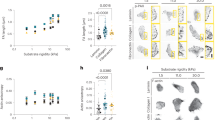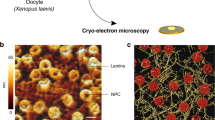Abstract
Nuclear lamins play central roles at the intersection between cytoplasmic signalling and nuclear events. Here, we show that at least two N- and C-terminal lamin epitopes are not accessible at the basal side of the nuclear envelope under environmental conditions known to upregulate cell contractility. The conformational epitope on the Ig-domain of A-type lamins is more buried in the basal than apical nuclear envelope of human mesenchymal stem cells undergoing osteogenesis (but not adipogenesis), and in fibroblasts adhering to rigid (but not soft) polyacrylamide hydrogels. This structural polarization of the lamina is promoted by compressive forces, emerges during cell spreading, and requires lamin A/C multimerization, intact nucleoskeleton–cytoskeleton linkages (LINC), and apical-actin stress-fibre assembly. Notably, the identified Ig-epitope overlaps with emerin, DNA and histone binding sites, and comprises various laminopathy mutation sites. Our findings should help decipher how the physical properties of cellular microenvironments regulate nuclear events.
This is a preview of subscription content, access via your institution
Access options
Subscribe to this journal
Receive 12 print issues and online access
$259.00 per year
only $21.58 per issue
Buy this article
- Purchase on Springer Link
- Instant access to full article PDF
Prices may be subject to local taxes which are calculated during checkout






Similar content being viewed by others
References
Swift, J. et al. Nuclear lamin-A scales with tissue stiffness and enhances matrix-directed differentiation. Science 341, 1240104 (2013).
Jaalouk, D. E. & Lammerding, J. Mechanotransduction gone awry. Nature Rev. Mol. Cell Biol. 10, 63–73 (2009).
Vogel, V. & Sheetz, M. Local force and geometry sensing regulate cell functions. Nature Rev. Mol. Cell Biol. 7, 265–275 (2006).
Trappmann, B. et al. Extracellular-matrix tethering regulates stem-cell fate. Nature Mater. 11, 642–649 (2012).
Wang, N., Tytell, J. D. & Ingber, D. E. Mechanotransduction at a distance: Mechanically coupling the extracellular matrix with the nucleus. Nature Rev. Mol. Cell Biol. 10, 75–82 (2009).
Sosa, B. A., Rothballer, A., Kutay, U. & Schwartz, T. U. LINC complexes form by binding of three KASH peptides to domain interfaces of trimeric SUN proteins. Cell 149, 1035–1047 (2012).
Crisp, M. et al. Coupling of the nucleus and cytoplasm: Role of the LINC complex. J. Cell Biol. 172, 41–53 (2006).
Isermann, P. & Lammerding, J. Nuclear mechanics and mechanotransduction in health and disease. Curr. Biol. 23, R1113–R1121 (2013).
Aebi, U., Cohn, J., Buhle, L. & Gerace, L. The nuclear lamina is a meshwork of intermediate-type filaments. Nature 323, 560–564 (1986).
Gerace, L. & Huber, M. D. Nuclear lamina at the crossroads of the cytoplasm and nucleus. J. Struct. Biol. 177, 24–31 (2012).
Senda, T., Iizuka-Kogo, A. & Shimomura, A. Visualization of the nuclear lamina in mouse anterior pituitary cells and immunocytochemical detection of lamin A/C by quick-freeze freeze-substitution electron microscopy. J. Histochem. Cytochem. 53, 497–507 (2005).
Dechat, T., Adam, S. A., Taimen, P., Shimi, T. & Goldman, R. D. Nuclear lamins. Cold Spring Harb. Perspect. Biol. 2, a000547 (2010).
Lammerding, J. et al. Lamins A and C but not lamin B1 regulate nuclear mechanics. J. Biol. Chem. 281, 25768–25780 (2006).
Solovei, I. et al. LBR and lamin A/C sequentially tether peripheral heterochromatin and inversely regulate differentiation. Cell 152, 584–598 (2013).
Guilluy, C. et al. Isolated nuclei adapt to force and reveal a mechanotransduction pathway in the nucleus. Nature Cell Biol. 16, 376–381 (2014).
Stuurman, N., Sasse, B. & Fisher, P. A. Intermediate filament protein polymerization: Molecular analysis of Drosophila nuclear lamin head-to-tail binding. J. Struct. Biol. 117, 1–15 (1996).
Heitlinger, E. et al. The role of the head and tail domain in lamin structure and assembly: Analysis of bacterially expressed chicken lamin A and truncated B2 lamins. J. Struct. Biol. 108, 74–89 (1992).
Strelkov, S. V., Schumacher, J., Burkhard, P., Aebi, U. & Herrmann, H. Crystal structure of the human lamin A coil 2B dimer: Implications for the head-to-tail association of nuclear lamins. J. Mol. Biol. 343, 1067–1080 (2004).
Kapinos, L. E. et al. Characterization of the head-to-tail overlap complexes formed by human lamin A, B1 and B2 “half-minilamin” dimers. J. Mol. Biol. 396, 719–731 (2010).
Khatau, S. B. et al. A perinuclear actin cap regulates nuclear shape. Proc. Natl Acad. Sci. USA 106, 19017–19022 (2009).
Kim, D. H. & Wirtz, D. Cytoskeletal tension induces the polarized architecture of the nucleus. Biomaterials 48, 161–172 (2015).
Shimi, T. et al. The A- and B-type nuclear lamin networks: Microdomains involved in chromatin organization and transcription. Genes Dev. 22, 3409–3421 (2008).
Manilal, S., Randles, K. N., Aunac, C., Nguyen, M. & Morris, G. E. A lamin A/C β-strand containing the site of lipodystrophy mutations is a major surface epitope for a new panel of monoclonal antibodies. Biochim. Biophys. Acta 1671, 87–92 (2004).
Isobe, K., Gohara, R., Ueda, T., Takasaki, Y. & Ando, S. The last twenty residues in the head domain of mouse lamin A contain important structural elements for formation of head-to-tail polymers in vitro. Biosci. Biotechnol. Biochem. 71, 1252–1259 (2007).
Amendola, M. & van Steensel, B. Mechanisms and dynamics of nuclear lamina-genome interactions. Curr. Opin. Cell Biol. 28, 61–68 (2014).
Stierle, V. et al. The carboxyl-terminal region common to lamins A and C contains a DNA binding domain. Biochemistry 42, 4819–4828 (2003).
Simon, D. N., Domaradzki, T., Hofmann, W. A. & Wilson, K. L. Lamin A tail modification by SUMO1 is disrupted by familial partial lipodystrophy-causing mutations. Mol. Biol. Cell 24, 342–350 (2013).
Collard, J. F., Senecal, J. L. & Raymond, Y. Differential accessibility of the tail domain of nuclear lamin A in interphase and mitotic cells. Biochem. Biophys. Res. Commun. 173, 363–369 (1990).
Pelham, R. J. Jr & Wang, Y. Cell locomotion and focal adhesions are regulated by substrate flexibility. Proc. Natl Acad. Sci. USA 94, 13661–13665 (1997).
Yeung, T. et al. Effects of substrate stiffness on cell morphology, cytoskeletal structure, and adhesion. Cell Motil. Cytoskeleton 60, 24–34 (2005).
Kihara, T., Haghparast, S. M., Shimizu, Y., Yuba, S. & Miyake, J. Physical properties of mesenchymal stem cells are coordinated by the perinuclear actin cap. Biochem. Biophys. Res. Commun. 409, 1–6 (2011).
Tee, S. Y., Fu, J., Chen, C. S. & Janmey, P. A. Cell shape and substrate rigidity both regulate cell stiffness. Biophys. J. 100, L25–L27 (2011).
Jain, N., Iyer, K. V., Kumar, A. & Shivashankar, G. V. Cell geometric constraints induce modular gene-expression patterns via redistribution of HDAC3 regulated by actomyosin contractility. Proc. Natl Acad. Sci. USA 110, 11349–11354 (2013).
Thery, M., Pepin, A., Dressaire, E., Chen, Y. & Bornens, M. Cell distribution of stress fibres in response to the geometry of the adhesive environment. Cell Motil. Cytoskeleton 63, 341–355 (2006).
Dupont, S. et al. Role of YAP/TAZ in mechanotransduction. Nature 474, 179–183 (2011).
Li, Q., Kumar, A., Makhija, E. & Shivashankar, G. V. The regulation of dynamic mechanical coupling between actin cytoskeleton and nucleus by matrix geometry. Biomaterials 35, 961–969 (2014).
Luxton, G. W., Gomes, E. R., Folker, E. S., Vintinner, E. & Gundersen, G. G. Linear arrays of nuclear envelope proteins harness retrograde actin flow for nuclear movement. Science 329, 956–959 (2010).
Stewart-Hutchinson, P. J., Hale, C. M., Wirtz, D. & Hodzic, D. Structural requirements for the assembly of LINC complexes and their function in cellular mechanical stiffness. Exp. Cell Res. 314, 1892–1905 (2008).
Constantinescu, D., Gray, H. L., Sammak, P. J., Schatten, G. P. & Csoka, A. B. Lamin A/C expression is a marker of mouse and human embryonic stem cell differentiation. Stem Cells 24, 177–185 (2006).
McBeath, R., Pirone, D. M., Nelson, C. M., Bhadriraju, K. & Chen, C. S. Cell shape, cytoskeletal tension, and RhoA regulate stem cell lineage commitment. Dev. Cell 6, 483–495 (2004).
Engler, A. J., Sen, S., Sweeney, H. L. & Discher, D. E. Matrix elasticity directs stem cell lineage specification. Cell 126, 677–689 (2006).
Ramdas, N. M. & Shivashankar, G. V. Cytoskeletal control of nuclear morphology and chromatin organization. J. Mol. Biol. 427, 695–706 (2015).
Taniura, H., Glass, C. & Gerace, L. A chromatin binding site in the tail domain of nuclear lamins that interacts with core histones. J. Cell Biol. 131, 33–44 (1995).
Goldberg, M. et al. The tail domain of lamin Dm0 binds histones H2A and H2B. Proc. Natl Acad. Sci. USA 96, 2852–2857 (1999).
Guelen, L. et al. Domain organization of human chromosomes revealed by mapping of nuclear lamina interactions. Nature 453, 948–951 (2008).
Towbin, B. D. et al. Step-wise methylation of histone H3K9 positions heterochromatin at the nuclear periphery. Cell 150, 934–947 (2012).
Talwar, S., Jain, N. & Shivashankar, G. V. The regulation of gene expression during onset of differentiation by nuclear mechanical heterogeneity. Biomaterials 35, 2411–2419 (2014).
Dittmer, T. A. & Misteli, T. The lamin protein family. Genome Biol. 12, 222 (2011).
Tse, J. R. & Engler, A. J. Preparation of hydrogel substrates with tunable mechanical properties. Curr. Protoc. Cell Biol. 10, 1–10 (2010).
Möller, J., Emge, P., Avalos Vizcarra, I., Kollmannsberger, P. & Vogel, V. Bacterial filamentation accelerates colonization of adhesive spots embedded in biopassive surfaces. New J. Phys. 15, 125016 (2013).
Acknowledgements
We thank M. Burkhardt, J. L. B. Khuan (IMRE, Singapore) and S. Früh for their valuable help with micropost and adhesive microisland substrates; M. Vihinen-Ranta and D. Hodzic for EGFP-lamin A and EGFP-KASH2 constructs, respectively; R. Foisner, O. Medalia, J. Lammerding and R. Fässler for LMNA null, VIM null, EMD null and WT MEF cells; U. Kutay for SUN2 antibody; K. Maniura for the usage of the Amaxa Nucleofector II system. This research was supported by Foundations’ Post Doc Pool, Finland (T.O.I.); Academy of Finland, grants 252225 and 267471 (T.O.I.); Portuguese Foundation for Science and Technology, doctoral grant SFRH/BD/42019/2007 (L.A.); SystemsX.ch - ‘PhosphoNetX’, Internal Nr. 2-67124-08 (V.V.); ERC Advanced Grant European Community, GA233157 (V.V.); and SNF Swiss National Science Foundation, Grant 310030B_133122 (V.V.). Computational resources provided by the Swiss National Supercomputing Center (CSCS) and the University of Tampere Imaging Facility are gratefully acknowledged.
Author information
Authors and Affiliations
Contributions
T.O.I., L.A. and V.V. designed the experiments. T.O.I. performed the PAA cushion experiments and L.A. carried out the LA/C-C epitope mapping. T.O.I. and L.A. did the remaining experiments with the help of J.M. (μ-island experiments) and R.S. (cell spreading experiments). F.H. was responsible for the structural analysis of lamin A and SMD simulations. All of the authors were involved in the analyses and interpretation of data. T.O.I., L.A. and V.V. wrote the paper, with the help of the co-authors.
Corresponding author
Ethics declarations
Competing interests
The authors declare no competing financial interests.
Supplementary information
Supplementary Information
Supplementary Information (PDF 1774 kb)
Rights and permissions
About this article
Cite this article
Ihalainen, T., Aires, L., Herzog, F. et al. Differential basal-to-apical accessibility of lamin A/C epitopes in the nuclear lamina regulated by changes in cytoskeletal tension. Nature Mater 14, 1252–1261 (2015). https://doi.org/10.1038/nmat4389
Received:
Accepted:
Published:
Issue Date:
DOI: https://doi.org/10.1038/nmat4389
This article is cited by
-
Nanotube patterning reduces macrophage inflammatory response via nuclear mechanotransduction
Journal of Nanobiotechnology (2023)
-
The Effect of Substrate Stiffness on Elastic Force Transmission in the Epithelial Monolayers over Short Timescales
Cellular and Molecular Bioengineering (2023)
-
The transcription factor PREP1(PKNOX1) regulates nuclear stiffness, the expression of LINC complex proteins and mechanotransduction
Communications Biology (2022)
-
Apico-basal cell compression regulates Lamin A/C levels in epithelial tissues
Nature Communications (2021)
-
Brick Strex: a robust device built of LEGO bricks for mechanical manipulation of cells
Scientific Reports (2021)



